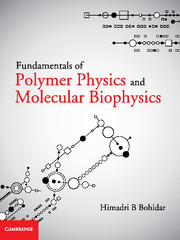Book contents
- Frontmatter
- Contents
- List of Figures
- List of Tables
- Preface
- 1 Essential Thermodynamic and Statistical Concepts
- 2 Polymer Structure and Nomenclature
- 3 Polymer Solutions
- 4 Phase Stability and Phase Transitions
- 5 Static Properties of Single Chains
- 6 Diffusion
- 7 Viscosity of Polymer Solutions
- 8 Sedimentation
- 9 Concentration Regimes and Scaling
- 10 Internal Dynamics
- 11 Dynamics in Polymer Gels
- 12 Molecular Biophysics
- 13 Structure of Biopolymers
- 14 Physics of Proteins
- 15 Physics of Nucleic Acids
- 16 Special Topics
- Index
- References
16 - Special Topics
Published online by Cambridge University Press: 05 August 2014
- Frontmatter
- Contents
- List of Figures
- List of Tables
- Preface
- 1 Essential Thermodynamic and Statistical Concepts
- 2 Polymer Structure and Nomenclature
- 3 Polymer Solutions
- 4 Phase Stability and Phase Transitions
- 5 Static Properties of Single Chains
- 6 Diffusion
- 7 Viscosity of Polymer Solutions
- 8 Sedimentation
- 9 Concentration Regimes and Scaling
- 10 Internal Dynamics
- 11 Dynamics in Polymer Gels
- 12 Molecular Biophysics
- 13 Structure of Biopolymers
- 14 Physics of Proteins
- 15 Physics of Nucleic Acids
- 16 Special Topics
- Index
- References
Summary
Coacervation
Coacervation is usually defined as a process during which a homogenous solution of charged macromolecules, undergoes liquid–liquid phase separation, giving rise to a polyelectrolyte rich dense phase. It is the spontaneous formation of a dense liquid phase of poor solvent affinity. The loss of salvation arises from interaction of complementary macromolecular species. The formation of such fluids is well known in mixtures of complementary polyelectrolytes. It can also occur when mixing polyelectrolytes with colloidal particles.
Following the pioneering work of Bungenberg De Jong (1949), coacervates are either categorized as simple or complex based on the process that leads to coacervation. In simple coacervation, the addition of salt promotes coacervation. In complex coecarvation, oppositely charged polyelectrolytes can undergo coacervation through associative interactions. The other liquid phase, the supernatant, remains in equilibrium with the coacervate phase. These two liquid phases are immiscible and therefore, incompatible. Complex coacervation of polyelectrolytes can be achieved through electrostatic interaction with oppositely charged proteins and polymers. The charges on the polyelectrolytes must be large enough to cause significant electrostatic interactions, but not precipitation.
Potential applications of coacervates are many starting from protein purification, drug encapsulation to treatment of organic plumes. This calls for better understanding of the coacervate structure and the transport of biomolecules inside this phase. Several questions pertaining to the structure of coacervates can arise. The foremost of these is: is it a gel-like or a solution-like phase?
- Type
- Chapter
- Information
- Fundamentals of Polymer Physics and Molecular Biophysics , pp. 303 - 318Publisher: Cambridge University PressPrint publication year: 2015



